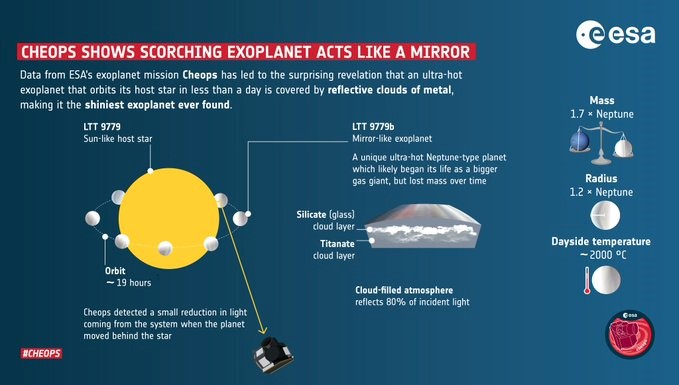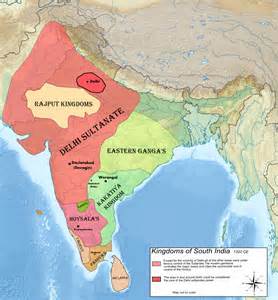Planet LTT9779 b & Cheops Satellite
Astronomers have found the most reflective planet ever discovered using data from the European Space Agency’s (ESA) Cheops satellite.
Planet LTT9779 b
- It is a newly discovered Neptune-like exoplanet that orbits a G-type star.
Planets that orbit a star outside the solar system are called as exoplanets.
- This exoplanet is about the size of Neptune and it is the largest mirror in the universe.
- The metallic clouds are mostly made of silicate and other metals like titanium mixed into the clouds.
- The blazing-hot exoplanet completes an orbit in less than a day.
- The burning planet is very close to its stars and has heavy clouds of metal floating while it rains drops of titanium.
- LTT9779 b can form metallic clouds despite being so hot because the atmosphere is oversaturated with silicate and metal vapours.
- The planet’s size and temperature make it what is called an ultra-hot neptune.
- Uniqueness - Planets so close to the host star do not have their atmosphere as their atmosphere will be blown away by their star, leaving bare rock.
- The planet has a thick layer of reflective metal clouds, essentially turning it into a gigantic mirror when viewed by observatories.
- The clouds reflect a lot of the starlight, preventing the planet’s atmosphere from getting too hot and evaporating.
- It reflects a massive 80% of the light it receives from its host star.
- The metals also mean that the atmosphere is too heavy to be blown away.

Venus has a thick cloud layer that reflects about 75% of the Sun’s light, brightest object in the night sky after the Moon and the Earth reflects around 30% of the incoming sunlight.
Cheops Satellite
- Agency - Cheops is European Space Agency's Characterising Exoplanet Satellite.
- Launch year - 2019.
- Orbit - Sun-synchronous.
- It is the first space mission dedicated to studying bright, nearby stars that are already known to host exoplanets.
- It focuses on planets in the super-Earth to Neptune size range.
References
1. The Indian Express | Planet ‘that should not exist’ is a gigantic mirror
2. ESA | Cheops
Rudragiri Hillock
Rudragiri hillock site unveils a fascinating combination of prehistoric rock paintings from the Mesolithic period and exquisite artwork from the Kakatiya dynasty.
- Rudragiri hillock is located at the Eastern Ghats, in Guntur district of Andhra Pradesh.
- It is named after King Rudra Deva of the Kakatiya dynasty.
- It features 5 naturally formed rock shelters at its foothills.
- It includes 2 natural caves at the southern end of the hillock
- It exhibits exceptional murals from the renowned Kakatiya kingdom.
- These shelters served as home for people during the Mesolithic age around 5000 B.C., and they bear witness to the luminous rock paintings of that era.
- The first cave, starting from the southern end of the hillock, presents a narrative mural portraying the intense battle between the Vanara brothers, Vali and Sugriva.
- A Ramayana fresco depicting Hanuman lifting the Sanjeevani hill with his right hand is painted on the Rudragiri hillock.
- In the middle cave, a grand sketch of Hanuman, accompanied by sacred symbols of the conch (Sankha) and the fire altar (Yagna Vedi) is shown.
- The 3rd cave houses the prehistoric rock paintings from the Mesolithic era.
- The Kakatiya artist chose the same rock shelter to superimpose the elegant figure of Hanuman, who is portrayed in a unique ‘Anjali’ posture, folding his hands in a divine offering.
- There is an evidence that Ramayana scenes depicted at Rudragiri might have drawn inspiration from the artworks at Muppavaram.
- Ganapati Deva Maharaja (1199-1262 AD), the founder of Muppavaram temple and a prominent figure of the Kakatiya dynasty, likely patronised the rich ancient mural heritage found at Rudragiri.
Other Findings
- There are some unknown ancient remains of Buddhist monasteries and a big rock shelter located on the top of the Rudragiri.
- The badly-ruined brick-built structural remains of an ancient Buddhist Vihara complex were found dating back to the 1st Century CE or 1st Century AD.
- This monastery flourished during the Satavahana period and was established by some donors for the Buddhist monks.
- Meditation and practising the principles laid by the Lord Gautama Buddha were the prime activities of the mendicant monks on the hilltop and these constructions are known as Saila viharas in contemporary inscriptions.
- The resident monks belonged to the Chaityakavadin sect of the Mahasanghika school of Buddhism, and their chief place of activity was Amaravati (Dharanikota).
Kakatiya Dynasty (1083-1323 CE)

- Founder - Rudradeva I.
- Capitals - Anmakonda (Hanumakonda), Orugallu / Ekasilanagara (Warangal).
- Languages - Telugu (preferred language), Sanskrit, Kannada.
- Religion - Jainism, Hinduism (Saivism).
- Famous rulers – Rudradeva, Mahadeva, Ganapatideva I and Rudramadevi.
- Temples - Thousand Pillar Temple, Ramappa Temple, Warangal Fort, Golconda Fort and Kota Gullu.
References
1. The Hindu | A fascinating fusion of rock art at Rudragiri hillock
2. The Hindu | Remnants of Buddhist monastery
Crimea Bridge & Kerch Strait
One of the sections of the rail-and-road Crimea Bridge, which links Russia to the occupied Crimea peninsula, was blown up on recently.
Crimea Bridge
- The Crimea Bridge is a crucial structure for Russia as it is the only direct link between the transport network of the country and the Crimean peninsula.
- It is the longest bridge in Europe and is also known as the Kerch Bridge.
- It was inaugurated on 2018, 4 years after Russia annexed Crimea.
- Port of Sevastopol is the historic home base of Russia’s Black Sea Fleet.
- Through this port fuel, food and other products are being supplied.
- Since last year, the bridge has also been an important conduit for reinforcements and supplies to Russian troops who have seized control of territory in southern Ukraine.
- For the Kremlin, the bridge is a symbol of the connection it is attempting to forge between Crimea and Russia.
Kerch Strait

- It is a strait in Eastern Europe.
- It connects the Black Sea and the Sea of Azov.
- It separates the Kerch Peninsula of Crimea and Russia.
References
1. The Indian Express | Attack on Crimea bridge
2. Britannica | Kerch Strait
Commission on Genetic Resources for Food and Agriculture (CGRFA)
The 19th session of the Commission on Genetic Resources for Food and Agriculture (CGRFA) meeting held at Italy recently.
- 2023 meeting - The meeting is taking place at the Food and Agriculture Organization’s (FAO) headquarters in Rome.
- Delegates and observers will deliberate on 3 matters
- A review of work on biodiversity, nutrition and human health
- Access and benefit-sharing for food and agriculture
- Digital sequence information for food and agriculture
CGRFA
- It is the only permanent intergovernmental body that deals with all components of biodiversity for food and agriculture.
- The commission was established in 1983 and completed 40 years of existence in 2023.
- Aim - To reach international consensus on policies for the sustainable use and conservation of genetic resources for food and agriculture and the fair and equitable sharing of benefits derived from their use.
- Members - 179 countries and the European Union.
- India is a member of this forum.
- The Commission deals with the diversity of domesticated crops, livestock and farmed fish and aquatic invertebrates, forest trees and aquatic species.
- Its mandate also covers the diversity of all the non-domesticated species that enable production.
- It’s one of the landmark achievement is the International Treaty on Plant Genetic Resources for Food and Agriculture (ITPGRFA).
International Treaty on Plant Genetic Resources for Food and Agriculture
- It was adopted by the 31st Session of the Conference of the Food and Agriculture Organization of the United Nations on 2001.
- Aim
- Recognizing the enormous contribution of farmers to the diversity of crops that feed the world
- Establishing a global system to provide farmers, plant breeders and scientists with access to plant genetic materials
- Ensuring that recipients share benefits they derive from the use of these genetic materials with the countries where they have been originated.
- The main provisions of the treaty comprises multilateral system, access and benefit sharing, farmers’ rights, sustainable use.
References
1. Down to Earth | Genetic resources commission gathers in Rome
2. Down to Earth | Will benefits from genetic resources reach communities?
3. FAO | Commission on Genetic Resources for Food and Agriculture
4. FAO | Treaty on Plant Genetic Resources for Food and Agriculture
Claude 2
AI start-up Anthropic unveiling the latest iteration of its AI chatbot Claude- 2
|
Chatbots
|
Claude 2
|
Bard
|
ChatGPT
|
|
Creator
|
Anthropic
|
Google
|
OpenAI
|
|
Accessibility
|
It is free to use for anyone.
|
It is free to use for anyone.
|
It is free to use for anyone.
|
|
Comparison of documents
|
Users can find commonalities between the two documents.
|
Users can upload images along with prompts, thus making Bard multi-modal.
|
ChatGPT can compare two documents
|
|
Information cutoff date
|
Early 2023
|
Early 2023
|
September 2021
|
|
Token Limit
|
Up to 1,00,000 tokens
|
Up to 2,000
|
Up to 8,912.
|
|
Regions
|
UK and the US
|
More than 180 Countries
|
Most of the countries in the world.
|
|
Languages
|
-
|
40 languages
|
-
|
|
Privacy
|
It allow users to delete their conversations and reportedly supports VPN browsing.
|
It comes with an option to auto-delete interactions in around 18 months.
It does not allow users to retrieve past interactions.
|
ChatGPT allows users to delete their interactions and it does not support VPN access.
|
|
Limitations
|
It lacks internet access and is likely to offer incorrect information if prompted with requests for real-world data.
|
It supports VPN access making it available across the world, bypassing local restrictions.
Bard’s API access is limited and context handling capabilities are significantly lesser compared to Claude 2.
|
It has fewer context-handling abilities than Claude 2.
It has been reported that while doing complex tasks, ChatGPT can throw up inappropriate results.
|
Reference
The Indian Express | ChatGPT, Claude 2, or Google Bard?

